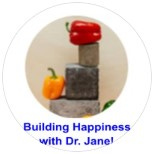This is referring to the ratio of positive emotions and negative emotions for each individual.
Why do we need to look into the “ratio”?
Why not going all the way with the positives? We all want happiness, right?
And who would want any sadness?
You might be surprised; negative emotions are not all “negative”/bad.
Not only that they exist for a reason (e.g., survival, and in modern times, focus when facing adversity), but also, negative emotions are actually a necessary part of our happiness.
Why do we need negative emotions in our happiness?
As discussed in another post, in our pursuit of happiness, we need to attend to all four areas: Global life satisfaction, domain life satisfaction, positive affect, and negative affect (see visual explanations in the video).
For negative affect (commonly called negative feelings) to be part of our considerations of happiness, there are at least two reasons.
Firstly, we need to keep it at a low level, so it would not overwhelm the effects of positive affect.
Secondly, we actually NEED it (at a low level, or I call it a “healthy dose”) in the mix of our affect (feelings) composition.
Negative feelings were built into us for a good reason.
It was vitally important for the survival of our ancestors. For example, fear prompted a “hide or flight” response; anger prompted a “fight” response against the aggressors….
In modern times, anxiety (when not excessive) prompts us to put in more efforts (e.g., mild anxiety could help athletes or test takers perform at their top capacity); worrying about something gets us to focus on finding a solution, so on and so forth.
But, when the level of negative affect gets high, it influences us negatively in many ways.
For example, when you feel “stressed”, that could indicate the anxiety becomes too much, overwhelming your confidence or concentration.
Not to mention more severe negative emotions, such as depressive mood, when prolonged, could harm our well-being on multiple levels.
So, the key is the right (or healthy) “ratio”.
According to the Broaden-and-Build Theory of Positive Emotions, we need multiple times as many positive emotions as negative emotions in order to thrive.
It makes sense as negative emotions tend to affect us more strongly than positive emotions (as in the saying “the bad is stronger than the good”).
We need much more positive emotions to overcome negative emotions’ effects on us; we then could build on that to thrive.
However, it is not “the more (positive) the merrier”.
Research showed that when positive emotions become overwhelmingly dominant, the “thriving state” starts to deteriorate.
It turns out, a small amount of the negative is actually healthy.
They keep us in balance.
People with predominantly positive emotions may be too often overly optimistic.
It could go against them; they may under-estimate or overlook the negative side of things that needs to be tended to, for example.
A “healthy dose” of negative emotions also keeps us in appreciation of the positives.
See more about this here: "How Much Happiness Do We Need to Make Up for Sadness?"?
So, our goal is NOT to get rid of all negative emotions, nor to suppress them.
Our goal is to keep them in check and in a “healthy dose” (as described in the cited posts above).
Actually, in my opinion, it may be more of a range rather than a specific number, so we may call it a “healthy range” instead of a “dose”.
An individual whose ratio falls within the healthy range has a “healthy ratio”.
Whether your level of negative emotions is in the “healthy ratio” can be measured by the amount of positive affect over negative affect, based on the “Broaden and Build” framework.
Research found that most of Americans have their ratios below the healthy range!
While that is alarming, it also shows that a lot can be done to improve our happiness just by raising this ratio.
But first we need to find out what our ratios are. What is your ratio?
A professional assessment is offered for free here for our monthly, yearly and founding subscribers, along with assessments of other aspects of happiness and related metric, all done individually and professionally.
Join in to get yours all measured out, then you could more clearly map out your happiness journey!




